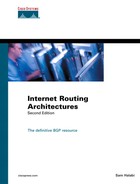Chapter 8. Controlling Routing Inside the Autonomous System
This chapter covers the following key topics:
-
Interaction of non-BGP routers with BGP routers— A brief overview of the methods by which non-BGP routers inside an AS can reach the outside world.
-
Defaults inside the AS: primary/backup policy— Different methods by which to avoid potential loops when default routing inside an AS conflicts with the goal of providing a primary and a backup link to outside the AS.
-
Defaults inside the AS: other BGP policies— An overview of routing policies other than primary/backup, which can lead to routing loops within the AS.
-
Policy routing— A definition and sample of a method of controlling routes, based on traffic source IP addresses or source and destination IP addresses rather than destination only.
The preceding chapter focused on the interaction between different ASs and how BGP attributes can be manipulated to address symmetry, redundancy, and load balancing. The discussion concentrated on the behavior of the BGP border routers that connect the AS to other ASs.
ISPs usually have most of their routers running BGP, perhaps with some leaf nodes running only Interior Gateway Protocols (IGPs). On the other hand, most customers have few routers running BGP, and the majority of their internal IGP routers default routing toward the BGP routers. In these scenarios, it is important to have the BGP policies go hand-in-hand with routing inside the AS. Conflicting policies might result in routing loops if the AS's physical layout does not complement the logical layout. This chapter discusses the interaction of BGP routes with IGPs inside the AS and presents the options of controlling routes via policy routing.
